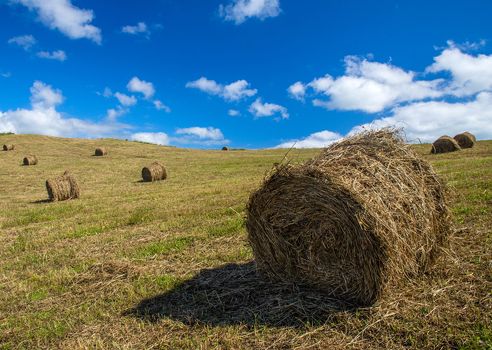Reading time: Less than 1 minute
Increase your vocabulary and you’ll make your writing much more precise. That’s why I provide a word of the week. Today’s word: rick….
My father grew up on a farm but I was born a city girl. As a result, I had never heard the word rick. Until, that is, I read Up From Freedom, a novel about race and identity in the pre-Civil War U.S. by Canadian writer Wayne Grady.
Here is how Grady used the word:
Now, in the evening, the heat of the day subsided, he was leading the horses from rick to rick while Rachel forked hay onto the bed, the sun’s low light slanting through the wheels.
Going by context, I had thought that a rick might be a piece of equipment onto which hay was loaded. But it turns out that a rick is usually the hay (or corn or straw) itself, built into a regular shape and thatched. (Subsequent research revealed that, depending on region, the term could also refer to the machine for cutting hay, or the wagon used to collect it.)
Loose hay would be taken to a dry storage area and built into a stack. The stack was made waterproof as it was built and the hay would compress under its own weight and cure by the release of heat from compression. The stack was fenced from the rest of the paddock in a rick yard, and often thatched or sheeted to keep it dry. When needed, slices of hay would be cut using a hay knife and fed out to animals each day.
There’s even such thing as a rick of wood: A standard one is four feet high, eight feet long, and roughly (never exactly) sixteen to eighteen inches thick. Woodstoves are generally built to handle 16-inch to 18-inch long splits of firewood, and most firewood-cutting chainsaws are sold with 16-inch bars, making measurement very simple. Three ricks also make a neat cord,
The etymology of the word is Old English, from hreac meaning “stack of hay or straw,” believed to have come from the Old Norse word, hraukr.
An earlier version of this post first appeared on my blog on Oct. 24/18.


